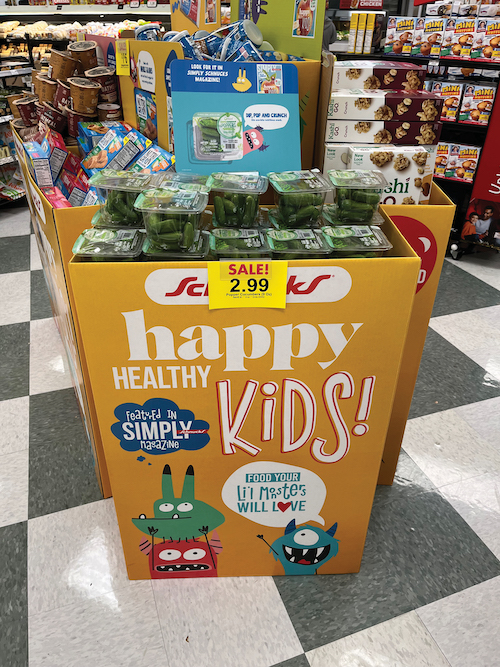What retail RDs do can reap some produce dollars

The fact that most Americans don’t consume enough fruits and vegetables is a data point well established.
But a group of retail professionals are working with grocers to improve the situation by providing education and inspiration at the point-of-purchase, both in-store and online.
More than 800 retail dietitians representing almost 10,000 grocery stores across North America promote healthier food items and help shoppers make choices that align with their nutrition goals, with an emphasis on produce, including through in-store and e-commerce activations.
Retailers have an important role to play in driving produce consumption, said Jonnell Masson, a registered dietitian and dietitian coordinator at Harmons, based in West Valley City, Utah.
Harmons’ dietitians and chefs provide inspiration for using produce with recipes on their website and e-commerce site, as well as make and promote convenient produce items including fresh-cut produce, ready-to-eat salad bar items and ready-to-cook produce like spiralized vegetables, diced peppers and a stir-fry blend of vegetables. The dietitians also write blogs and create social media content on healthy eating, with produce at the center.
Read the rest of PMG magazine's March/April 2023 issue, digitally
Retailers with registered dietitians on staff have an added advantage in that they’re qualified and equipped to educate consumers, which in turn can help increase consumer produce purchases, said Emily Krause, health and wellness manager at Coborn’s, based in Saint Cloud, Minn.
“We give practical advice on how shoppers can incorporate their produce purchases into their lifestyle and not let those purchases go to waste — therefore increasing the chance that they will continuously come back to purchase more produce because they are consuming it at home,” she said. Krause is a registered dietitian, licensed dietitian and fellow of the Academy of Nutrition and Dietetics with a master’s degree in family and consumer sciences.
Every January, Natural Grocers, based in Lakewood, Colo., offers a companywide class series. The 2023 focus was a seven-day challenge to eat the Regenivore Meal Wheel, which requires half of each meal and snack to be composed of fruits and vegetables, said Caroline Cheong, director of nutritional health coach regional managers, and Shelby Miller, director of scientific affairs and nutrition education, both at Natural Grocers. Customers can earn a coupon booklet for attending the class.
In-store RD programs
Retail RDs use a variety of programs in-store to drive produce purchase and consumption.
Healthy Path Market in Puerto Rico offers a $30 produce voucher for shoppers who attend a follow-up appointment at the in-store nutrition clinic. In the last six months, 97% of clients used their vouchers, said Mariely Rosado, registered dietitian nutritionist at Healthy Path Market. To provide more guidance in the produce department, they have “Dietitian’s Pick” signage that identifies best sources of vitamins and minerals. The “Cocina Salud” (Cooking Health) program
is designed to provide in-store cooking classes with emphasis on how to combine foods, flavors, colors and My Plate groups to create great meals that are appetizing and healthy. My Plate is a personalized USDA food plan based on age, height, weight, gender and physical activity level. The Healthy Path Market program provides meal prep options that include produce items.

Nutrition health coaches at Natural Grocers provide inspiration through in-store recipe demonstration classes, with produce-focused options like Avocado Awesomeness, Let’s Eat Beets, Get Spiralized and Satisfied, and Veggies – It’s What’s for Breakfast. Harmons offers Healthy Checkout Lanes; the RDs have worked to have whole fruit and convenient cut fruit and vegetable cups in these lanes and partner with the produce team to promote new produce trends and coordinate seasonal produce items for these lanes.
Allison Primo, a dietitian at St. Louis-based Schnucks, has worked with internal teams on health-focused shopper marketing campaigns to influence consumers to choose healthier items across the store, including in the produce department. This campaign shows up across multiple platforms, including the use of blade signs, in-store marketing drop-down tags, and bins to cross- merchandise items.
A unique offering at Coborn’s to drive produce purchases is the Chop Shoppe, where shoppers can have fruits and vegetables cleaned and prepped. “We recommend consumers purchase from our Chop Shoppe if [their] budget allows,” Krause said. “Removing the barrier of washing and prepping produce allows for easier snacking, roasting and cooking for those who struggle to use the produce they do purchase.”

Buying produce online
Of the 42% of consumers who buy groceries online, 58% purchase fruits and 48% purchase vegetables, according to research firm Category Partners, Idaho Falls, Idaho. These rates compare to weekly in-store purchases at 88% for fruit and 84% for vegetables.
As a way to drive online produce purchases, registered dietitian Raman Khatar and her team at Save-On-Foods in Langley, British Columbia, have created a series of shoppable lifestyle pages on the e-commerce site, prominently showcasing produce items within various eating plans that shoppers choose to follow, such as plant-based eating, keto-friendly and heart- healthy eating. Harmons offers similar e-commerce inspiration in RD-curated and shoppable collections that prominently highlight produce. For Coborn’s e-commerce, there’s a link to shoppable recipes that always have produce items listed, making it easy for shoppers to add fruits and veggies to their virtual carts, Krause said. Also, RDs have seen great success in offering virtual children’s cooking classes as well. Parents can add recipe ingredients to their digital carts when they register their children for the classes.
Using media
Retail dietitians extensively use social and traditional media to drive produce purchases online and in-store. Rosado visits nearby farms to promote local produce items carried in her Healthy Path stores, and she livestreams her visits on social media to engage shoppers.
Coborn’s dietitians do regular media spots on Twin Cities stations. A segment on reducing food waste specifically with produce was picked up five times in one week.
“Some of our most popular social media content has been on how to cut produce correctly,” Krause said. “Our most popular reel was on how to cut a mango, which had 25 times more views than an average post.”
Retail RDs have greatly expanded the number of current and potential new shoppers they reach through social and digital programming. It’s one way they track the return- on-investment of their programs.
These health influencers track their impact on produce sales lifts, basket size, frequency of visits, company brand image and shopper loyalty. As one of the most trusted sources of foods to eat or avoid, dietitians are leveraging all the tools in the retail toolbox — plus a few of their own — to increase produce buying and consumption along the entire path to purchase.
---------
Annette Maggi is a registered dietitian and licensed dietitian nutritionist who earned her master’s degree in science and is a fellow of the Academy of Nutrition and Dietetics. Maggi is president of Annette Maggi & Associates Inc., a nutrition marketing and communications consulting firm specializing in the interface between food manufacturers and retail grocers, and nutrition and regulatory issues. She is considered a leading expert on health and well-being in the retail space.







